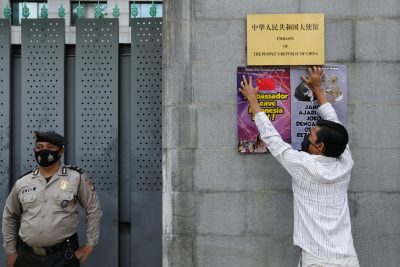Author: Maria Alynna Corinne M. Carlos, University of the Philippines
The South China Sea (SCS) is highly prized for its economic and strategic value. Competing claims over the maritime area have slowed multilateral cooperation among states and disputes have been counter-productive to resolving security concerns in the region. Beyond territorial borders, terrorism, transnational crime, and environmental degradation are rife in the SCS. In response, ASEAN claimant states should pursue minilateralism to achieve multilateral goals through smaller and more functional arrangements.

Minilateralism brings the ‘the smallest possible number of countries needed to have the largest possible impact in solving particular problems.’ These smaller groupings make minilateralism a distinct framework between bilateralism and multilateralism.
ASEAN multilateralism is complicated by its large size, with each of its 10 members exercising varying relations with the United States and China. With four ASEAN claimant states having competing interests in the maritime domain, the organisation is bound to meet serious challenges when balancing their national and regional interests in the SCS. This makes the present multilateral framework ineffective for moving beyond statements and confidence-building measures.
Cooperation is marred by the lack of agreement on a Code of Conduct (COC) and efforts to negotiate one with China ‘went nowhere’, according to then-Philippine foreign affairs secretary Teodoro Locsin Jr in 2021. Still, ASEAN must be credited for consistently including the SCS in its agenda. At the May 2022 US–ASEAN Summit, a joint statement emphasised the importance of pursuing practical measures in the SCS to reduce tensions and the risk of accidents, misunderstandings, and miscalculations. But ASEAN states cannot move forward on SCS issues without a COC with China.
As a regional organisation, ASEAN must take steps to address issues in its multilateral setup. States have the option to voluntarily engage in informal and ad hoc minilateral arrangements. The flexible nature of minilateral arrangements allows states to respond to issues that cannot be resolved at the multilateral level. But these minilateral arrangements must be carefully designed to complement and not compete with any ongoing multilateral efforts between ASEAN and China.
The SCS issue is an opportunity for ASEAN to assert its centrality in regional security issues where minilateral cooperation already exists, including the Trilateral Cooperative Arrangement between Indonesia, Malaysia, and the Philippines in the Sulu–Sulawesi Seas. Another example is the Malacca Straits Patrol between Indonesia, Malaysia, and Singapore. A similar arrangement can be employed in the SCS. With the voluntary participation of the Philippines, Brunei, Vietnam, and Malaysia, a small grouping anchored on building trust and deepening cooperation could emerge.
Common issues among claimant states in the SCS include land reclamation activities and damage to the marine environment. These shared security concerns can be used to organise minilateral groupings and to remove constraints found in a multilateral setting.
The Joint Oceanographic and Marine Scientific Research Expedition (JOMSRE) between the Philippines and Vietnam has great potential for scientific research and is an example of a successful bilateral grouping. States may also learn from the now-suspended joint oil exploration activities between China and the Philippines. Expanding these bilateral arrangements to include more states would be an opportunity to build trust and confidence among concerned parties.
While a minilateral arrangement could provide short-term solutions, the proposed workaround is not meant to be a long-term solution to multilateral problems. The ‘ASEAN minus X’ formula adopted in economic affairs paves the way for future multilateral arrangements in addressing security issues in disputed areas such as terrorism, transnational crime, natural disasters, and environmental degradation.
The proposed minilateral approach will make ASEAN states the drivers of the initiative, while still asserting ASEAN centrality despite the change in setup. An agreement on the COC would be a milestone for ASEAN multilateralism. But it is crucial that the ASEAN thinks ahead and deliberates its next steps even before states can agree on a COC. If member states do not address concerns as early as now, ASEAN multilateralism will be left in a bad state, even with a COC.
While waiting for an agreement on the COC, minilateralism offers ASEAN room to move beyond joint statements and informally discuss ways forward on the SCS. ASEAN faces its biggest challenge and opportunity to prove its strength as an institution and assert its centrality over the SCS issue.
Alynna Carlos is a program and research associate at Stratbase Albert del Rosario Institute. She is currently writing her thesis on ASEAN minilateralism to complete her master’s degree in international studies at the University of the Philippines.
The post Can minilateralism in the South China Sea finally generate progress? first appeared on East Asia Forum.
Source link





